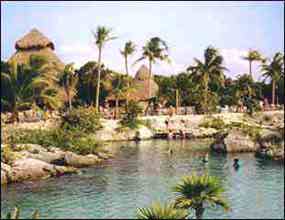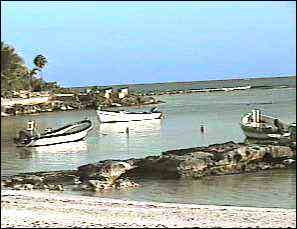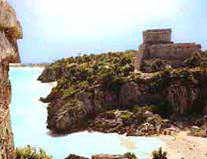Yucatan’s Sunny
Caribbean Coast
Snorkel Beautiful Lagoons and Explore Mayan Ruins
| Adjusting our masks, we slipped into the blue-green waters of Xel-Ha Lagoon. Colorful fish beckoned from every direction. Snorkeling slowly across the lagoon, we took many detours, circling submerged rock groupings, each with its own sea colony. Approaching the far shore we noticed a small stingray, fluttering the bottom sand in an effort to conceal itself. Suddenly, two huge fish caught our eye next to the far shore’s limestone wall. The striking purple, green, and orange colors indicated that these monsters were Yucatan’s famous parrot fish. Although we’d heard of these beauties, we were unprepared for their splendor and magnificence. Xel-Ha's wonders had whetted our appetites for more explorations. |  |
The Mexican Caribbean
 |
Sandy, white beaches with offshore coral reefs, coastal lagoons and cenotes (limestone sinkhole pools) are the signature of the Yucatan’s Caribbean coast. In contrast to busy, high-rise Cancun, the 40-mile section of coastline between Playa del Carmen and Tulum offers many secluded areas and less-developed resorts with a good balance of quiet and convenience. Playa del Carmen lies 40 miles south of Cancun. It is well laid out, with no high-rise hotels. Playa’s most striking assets are the alabaster-white beach with its offshore reef, and two main streets with a variety of shops, restaurants, and resorts. The small pier provides ferry service with Cozumel. |
| Xcaret was a Mayan port city, now developed into an educational theme park. The beautiful coast and lush vegetation contain a variety of ruins. This is a place where you will want to spend the entire day exploring, including a botanical garden, museum, aquarium, bird sanctuary, stables, dive shop, and several restaurants. The exciting cenote float through limestone caves is a memorable adventure, and the twice-weekly Mayan folklore dinner show includes a walk through the candle-lit Mayan village. |  |
 |
Akumal is the perfect choice for the vacationer who wants to enjoy snorkeling, diving, windsurfing, and expansive beaches. There are three distinct areas. Akumal proper has a small Mayan community and a large resort. World-class diving lies just 500 feet offshore at the exceptional coral reef with its sunken galleon. Deep-sea fishing and windsurfing are also available. South of Akumal is a long, shell-filled beach and the resort of Akumal Aventuras. We stayed north of Akumal at Half Moon Bay, the most secluded beach, ringed with private homes and condos. Nearby Yalku is an isolated, cenote-fed lagoon providing excellent snorkeling in crystal-clear waters. As at Xel-Ha, we were fortunate to see parrot fish in the deeper waters. |
| Xel-Ha Lagoon is a natural aquarium, created by the lime-stone coastline as it meanders inland for hundreds of meters. This is a very popular tourist destination, and early arrival is recommended You can explore cenotes and underwater caves which go into the jungle from the far end of the lagoon. A glass-bottom boat trip is also available for non-snorkelers who want to view the lagoon’s wonders. Xel-Ha is a national park with a good array of facilities, including sunning beach, snorkeling rentals, restaurant, souvenir shop, and museum. |  |
Mayan Ruins of Tulum
The exploratory highlight of this region is Tulum. This was the largest Mayan coastal city, with a commanding position on cliffs overlooking the Caribbean. It served as an important Postclassic (AD 900-1540) Mayan distribution point for coastal canoe trade. Wide stone causeways linked Tulum with Xel-Ha and Coba, 26 miles west. Tulum was the sole city still inhabited by the Maya when the Spanish Conquistadors arrived in 1518. Although never conquered by the Spanish, the Maya abandoned Tulum by the end of the century.
 |
 |
 |
High walls enclose Tulum’s grassy 60-acre site on three sides, leaving the Caribbean open to the east. Approximately 2,000 priests, rulers and servants lived here, while approximately 20,000 Mayans settled outside the walls. A number of significant buildings are still standing, including the impressive Castillo, believed to be a sea look-out. Its walls have carvings of the Descending God and columns depicting Kukulcan, the serpent god. The nearby Temple of the Frescoes displays Classical Mayan architecture and frescoes. It also includes a solar sighting tunnel that illuminates a wall at the solar equinox. Due to the wish to preserve these sites, all the building interiors are off-limits.
 |
Return to Paradise With a large share of the world’s most beautiful sporting waters and beaches, coupled with the magnetism of its Mayan ruins and its friendly present-day Mayan residents, Yucatan’s Caribbean coast serves up an unbeatable combination. We have already set a return date for vacationing at Akumal and exploring additional waters, Mayan sites, and the Sian Ka’an Biosphere Reserve just south of Tulum. |
Click here for details to plan your own trip to Yucatan’s Caribbean coast.
Les Furnanz